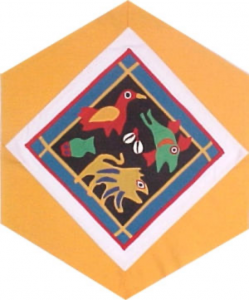Benin

The Block
Mme. Fernande Houngbedji, of the Benin Embassy in Ottawa found inspiration for the block in Benin’s royal history. The vibrant cotton animals in primary colours represent three of the twelve kings of Dahomey, Benin’s former name. They come to life against the black background on which they were appliquéd by Sue Robertson. Reflecting this traditional art form performed by only the men of Benin, the motif imaginatively teaches the history and stories of their leaders. Each king took a specific symbol, characterizing his reign and attributes. Clockwise from nine o’clock are the melodic drum and Gangnihessou bird representing the powerful and influential first king of the same name. The diving shark that follows is a symbol of the intelligent and courageous 11th king, Behanzin. The mighty lion completing the display is attributed to the spirited 10th king, Glele. Cowrie shells, once used as currency, are hand-stitched in the centre.
Cultural Profile
Benin is a small, ancient land of Western Africa. Its southern region, bordering the Atlantic, is dotted with lakes and rivers, where the villages, built on stilts and only accessible by canoe, draw many visitors. One of them, the town of Ganvié, is home to almost 20,000 people living in stilt houses, making it the largest lake village in Africa.
A country with a vibrant cultural history, its diverse population represents over 40 ethnic groups, the main four being Fon, Aja, Yoruba and Bariba. The city of Abomey was the seat of the kings of the powerful kingdom of Dahomey between the 17th and 19th centuries. Their royal palaces, which at one point housed up to 8,000 people, still stand to this day. Although each ethnic group has its own centuries-old traditions, French colonial rule and subsequent ties with France have had an impact on all aspects of cultural life. French is the official language, but most people speak their native tongues for their day-to-day life. These languages are used in elementary schools, contributing to their preservation.
Benin is considered to be the birthplace of vodun, a belief that human and spirit worlds are interconnected, that all things are divinely created and therefore worthy of worship. Vodun travelled to the Americas during the years of the slave trade, where it evolved into voodoo beliefs. Even though a majority of Beninese are Christians, the rituals of vodun are still deeply entrenched in the country and its culture.
Craft traditions are rich in Benin, with individual ethnic group having its own. Since the country grows large amounts of cotton, its textile arts are strong. Appliqué, a textile art that was most prized by the kings of Dahomey, was used to adorn tapestries, umbrellas, flags and buildings with each king’s symbol during his reign. It is now widely done in Benin. Weaving was also done in the old kingdom to make cloth adorned with the royal symbols. Today, each of Benin’s ethnic groups still preserves their unique style of weaving to produce their distinctive clothes. For example, the Yoruba of Eastern Benin make the Aso Oke, or the Ewe of the East weave kente cloth. Benineses, in keeping with most West Africans, use colourful wax printed cotton for everyday clothes and headgear. The country is also known for its ancient carvings, cast brass or copper pieces, pottery and leatherwork.
Beninese have been coming to Canada since 1976, mainly for economic reasons. Their numbers are quite small, standing at around 2,660 in 2011.
Sponsor: Town of Mount Royal Adult Centre
